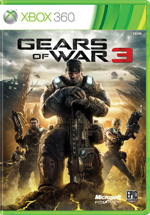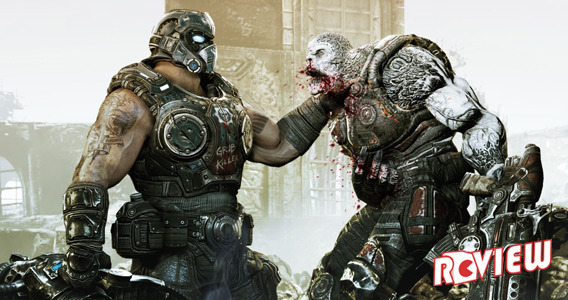
So, here’s Gears of War 3 in a nutshell: somewhere on the battlefield, a Locust drone fell to his knees, and out I ran—because it wasn’t acceptable that he might just bleed out. I had to get to him, so that I might ram my flamethrower into his chest and burn him from the inside out.
Yeah, that’s a thing you can do.
I think what makes Gears of War special, as a franchise, is its unique aptitude for making me want to do things like that, and, more importantly, for making me need to shoot monsters.
That’s the impetus of any shooter, of course, but the focus here is notably more pure. Every asset is leveraged toward this end. Whether it’s brutish dialogue that can only rightly be answered with a shotgun, the satisfying kick of the rifle, the suffering atmosphere of the world, or a story that demands good old-fashioned revenge, everything in this game compels me to shoot monsters, and fashions that need into the most satisfying experience possible.
It’s the art of the shooter, and Gears of War 3 is a symphony on the subject.
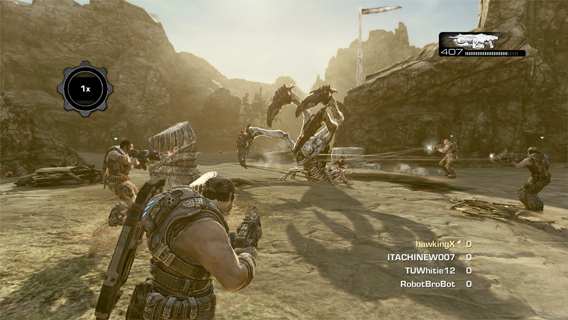
The story, such as it is, brings you monsters to shoot and gives you cause to shoot them. It constructs scenarios in which there might be different monsters—crawling monsters, slither monsters, flying monsters, or perhaps glowy, explody monsters that offer a different tactile response for your shooting, such that it creates a broader and more satisfying monster-shooting experience.
When a character speaks, it’s usually about the monsters that were just shot, or how they might go about shooting the new batch of monsters cresting on the horizon.
Hell, even “stealth” is about shooting the right monster at the right time.
So, you understand: there are monsters, and you’ll shoot them. What’s important to note is that Gears of War 3 provides the most finely crafted, robust experience for the shooting of monsters in the franchise.
Let’s start with weapons. There’s been expansion here, but it’s light: for the most part, the weapons on tap are the same as always. The few additions available feel more like alternate versions of existing weapons than truly new tools of destruction, but though the differences are subtle, they are not unimportant.
Selecting an arsenal is more about finding the gun that fits more than anything else. Consider: all three assault rifles do the job, but each has a distinct sensation and subtle differences in application that will see many players married to one particular type or another. For example, once I had picked up the Retro Lancer, I needed it in my loadout always, at the expense of all other weapons. I’d committed.
Similarly, once I had incendiary grenades, they were the only grenades I wanted, and when I got a hold of a Gorgon pistol, no other handgun could cut it.
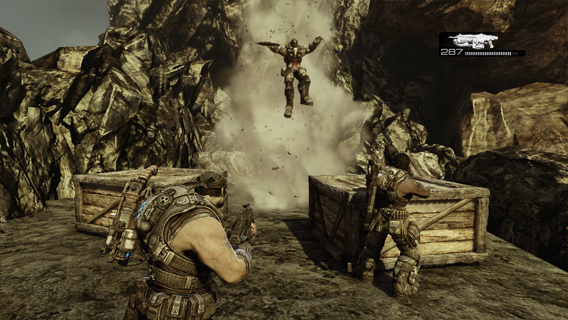
I’d found my niche, and that’s the design imperative with the arsenal. It’s not about finding the right weapon for the job, because every weapon is the right weapon for the job. It’s a matter of discovering the weapons that provide the most satisfying sensation for the particular player.
This is where Epic has done its work since Gears of War 2. It is, by and large, a sequel made up of tweaks and adjustments and small additions, all tuned toward giving the player more reasons to want to shoot that monster in the face, or run out in the open and finish him off.
Even the notorious goofy writing, when viewed through this lens, makes a certain kind of sense. The oafish bravado is, admittedly, a little infectious.
Gears 3, though, does provide something of an improvement in terms of storytelling. It is by no means a grand opus, but of the three games, it provides the most emotionally resonant and sincere experience. Now, I cannot stress enough that the terms “emotionally resonant” and “sincere” should be understood as existing on the Gears of War scale, and should not be taken the same way they would be if I were to use them when discussing, say, Mass Effect.
Simply put, Gears 3 has moments that are a little more human, where its characters aren’t responding to their surroundings through the medium of the Gruff One-Liner, and unlike the attempts in the previous entry, these (mostly) work. It’s refreshing to see that Marcus and his cohorts can muster more than an “Aw, shit!” in response to the horrific circumstances they find themselves in—though that’s not to say there aren’t more than enough inappropriate “Aw, shit!” moments to go around.
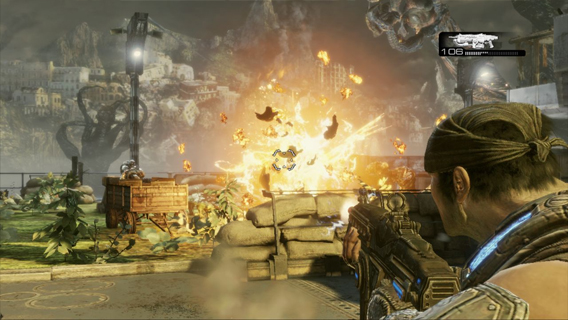
The plot ties back to elements of the first game, and there’s some interesting material here—though the mythology is certainly not the equal of some other notable franchises, and there are some noticeable holes in the tapestry. Certain plot threads disappear while others contradict themselves, but it’s fair to say that a more cohesive story is told here than in the other entries in the series.
Gears of War 3’s storytelling doesn’t succeed through well-formed characters or intriguing world-building, but with atmosphere. Mood is layered on every moment with a wide brush, creating an immense, crushing hopelessness that permeates even moments of victory.
The key is the incredible work of the game’s art design. It’s no secret that graphical prowess is a big deal for the people behind the series, and it’s not difficult to understand why: when you have art this good, you want to present it in the best way possible. The beautifully grim, miserable world of Sera looks as good as anything on consoles today, and the aesthetic of Gears is much improved by an expanded palette of colors and environments—adding lush jungles and some almost quaint villages to the usual backdrop of grey, worn cities.
Even the multiplayer maps are beautiful, bleeding atmosphere. I’ve never given much thought to the aesthetics of online killing fields, but it’s just impossible not to notice the caliber of work that’s been done here. There’s no better looking environment for blasting drunken frat bros—and yeah, that’s right: Gears of War 3 even makes blasting bros better!
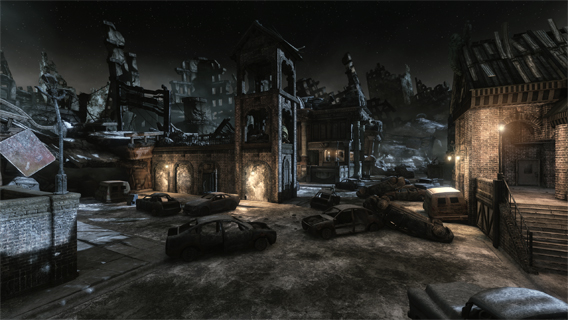
The multiplayer and online suite is also where you’re going to find the bulk of the sequel’s new features.
Online co-op now supports up to four players (while splitscreen remains at two), and a new twist has been added in the form of the competitive scoring mode. When enabled, players compete to earn points for kills and the like, while mutators can be added to introduce unique challenges—for example, I played a round where ammo pick-ups were disabled, meaning ammunition could only be scrounged from the weapons of fallen enemies.
Versus has seen a few adjustments—along with the new weaponry introduced in the campaign—though the only new mode is the Gears of War take on traditional Team Deathmatch, which works well for players looking for a faster-paced game. Make no mistake, though: Gears remains Gears. If you’re not prepared to be ground down by guys with shotguns, you shouldn’t be playing. It isn’t strictly the most balanced experience, but there’s always a way to survive and a way to succeed if you know the strengths (and more importantly, the limitations) of your chosen weapons.
The biggest draws, though, are going to be the re-invigorated Horde mode, and the new Beast mode.
Perhaps taking note of how Horde was played (and the maps it was played on) in Gears 2, Epic has redesigned Horde to play more like a tower defense game. Base defenses can be purchased, upgraded, and repaired between rounds, serving to slow enemies (or turn them to paste more efficiently)—and it’s a good thing, because Horde mode is now significantly more difficult, now forcing players to contend with a wider array of more powerful enemies—including the iconic Corpsers.
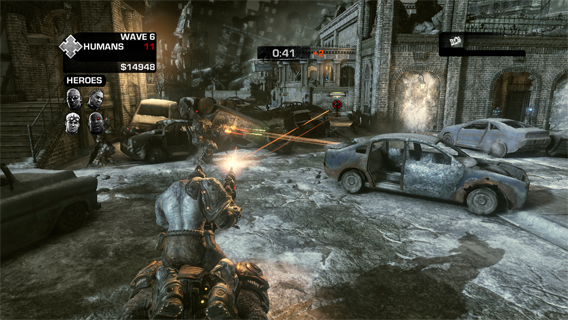
Meanwhile, Beast mode offers the opportunity to take control of these monsters—nearly the entirety of the Locust army laid bare. Beast mode may prove to be the runaway hit that Horde mode was for Gears 2, as it provides an entirely new, distinct way to play the game.
It is very much the reverse of Horde mode: players control Locust who (unlike the AI COGs) can respawn endlessly, and must eliminate the Gear opposition within the time-frame. Locust are less well-rounded than the COGs; they don’t regenerate health, they only carry one weapon at most (a pre-determined weapon, at that), many of them cannot take cover, and several are slow-moving or otherwise suffer limited mobility.
However, they are characterized by unique abilities that make them extremely dangerous, especially when the different types work together. Kantus can heal nearby allies, Boomers wielding flails can smash through COG barriers with ease, and Corpsers can burrow underground to escape danger—playing as the Locust horde is a completely new, refreshing experience that is going to add a significant amount of replayability and longevity to the title.
Gears of War 3 isn’t daring new product; it’s Gears of War. Like other triple-A franchises, its progress is incremental, but not insignificant: it makes its mark in carefully expanding and refining its core experience more often than it does by breaking new ground, and for this, Gears of War 3 is easily the best in the series. Ultimately, if you’re looking for the best possible monster-shooting experience, I am hard-pressed to think of a superior option.
Epic Games
Distributor
Microsoft Studios
System
Xbox 360
Modes
Singleplayer, Multiplayer, Online and Splitscreen Co-op
Release Date
September 20, 2011
*A copy of this title was provided by the publisher for review
